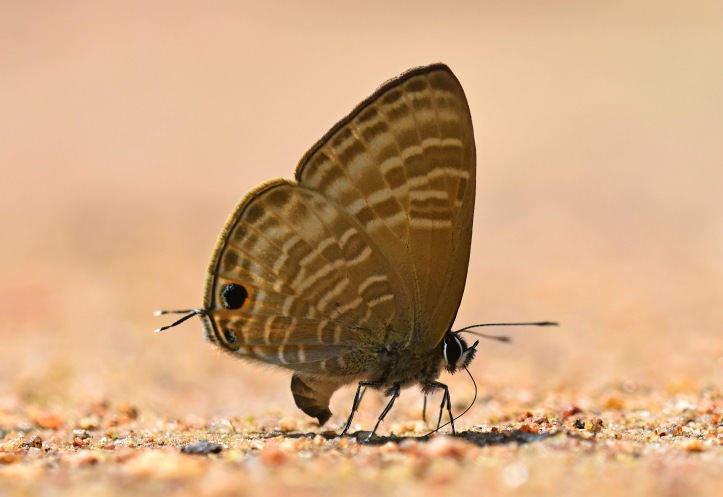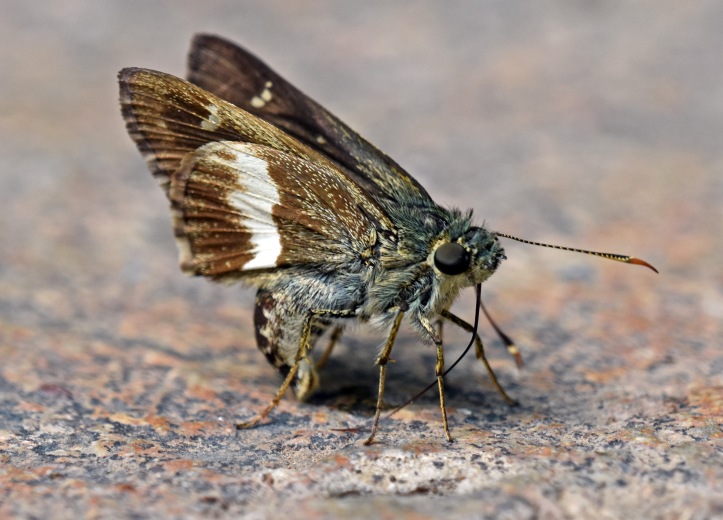
Adult butterflies feed on a variety of fluids, including nectar, water, damp substrates (mud), rotting fruit, excrement and so on. The term ‘mud puddling’, or just puddling, is usually used to describe any sort of feeding that is not nectaring, i.e. feeding on flowers. Male butterflies in particular need to stock up on sodium and nitrogen to help them synthesize spermatophores – the nuptial gifts that they give to females as their contribution to bringing up the next generation!

Essentially what they are doing, is obtaining compounds and substances that they need – sodium and potassium salts, amino acids, sugars and so on – to perform vital activities, like reproduction. They are also making up for any deficiencies in their diet as caterpillars.
Butterflies often seem to puddle on what appear to be surprising unproductive substrates: hard rocky or stony ground, and even concrete! Sometimes they are sucking up a microscopic film of water, but usually it is the salts and dissolved substances that they are trying to obtain. Some places must contain very high concentrations of such compounds, because butterflies return to puddle there, year after year.

Like us, butterflies also have to regulate their internal milieu: they need to maintain relatively constant levels of salts and water in their blood (haemolymph); a process called osmoregulation. Nectar usually contains quite a high concentration of sugars, and butterflies often produce an excess of water, which must be got rid of somehow; either by evaporation or excretion.
So if you have a lot of pee you want to get rid of after imbibing rather too much free nectar, what better way to do it than to use it to dissolve some of those hard, but tasty substrates! Bird droppings are particularly attractive, being high in phosphorus and nitrogen, but they are often rock hard and need to be incorporated in a liquid solution. So why not squeeze out a droplet of urine and let it dissolve those tasty nutrients? Then suck up the delicious drink! This is recycling. The butterfly proboscis is a highly efficient device for soaking up fluids via capillary action once some moisture has been added.

Here we see (below) a little skipper which has excreted a drop of urine onto a small white patch of what I think is a bird dropping. Notice how the proboscis is angled backwards under the body and the abdomen is pointing downwards. Urine out, liquid in. Excreting and imbibing: recycling.

The abdomen of the butterfly engaged in recycling is typically bent downwards towards the ground, prior to excreting a droplet of urine.

Skippers (Hesperiidae) are particularly noted for recycling, but there are many other species in other butterfly families which also carry out this activity, I think. Like this colourful nymphalid (below).

All photographs taken in Thailand.
For a fantastic blog on urine droplets and recycling from the Butterflies of Singapore site, see here.
References
Boggs, C. L., & Jackson, L. A. (1991). Mud puddling by butterflies is not a simple matter. Ecological Entomology16(1), 123-127.
Monaenkova, D., Lehnert, M. S., Andrukh, T., Beard, C. E., Rubin, B., Tokarev, A., … & Kornev, K. G. (2011). Butterfly proboscis: combining a drinking straw with a nanosponge facilitated diversification of feeding habits. Journal of the Royal Society Interface, rsif20110392.
Nicolson, S. W. (1998). The importance of osmosis in nectar secretion and its consumption by insects. American Zoologist, 38(3), 418-425.
Not something I’ve witnessed must pay a bit more attention! Especially with the Emperors.
This is brilliant and makes perfect sense. However, are there any risks in the butterfly imbibing its own gut parasites or eggs of same which might be deleterious?
Not sure, but they seem to thrive on it!
[…] near Chiang Mai in Thailand. The butterfly was preoccupied with ‘puddling’ – and recycling its wee! – on patch of dried bird dropping, on a leaf, and allowed me to approach it quite closely. I […]
[…] Puddling, peeing and recycling in butterflies […]